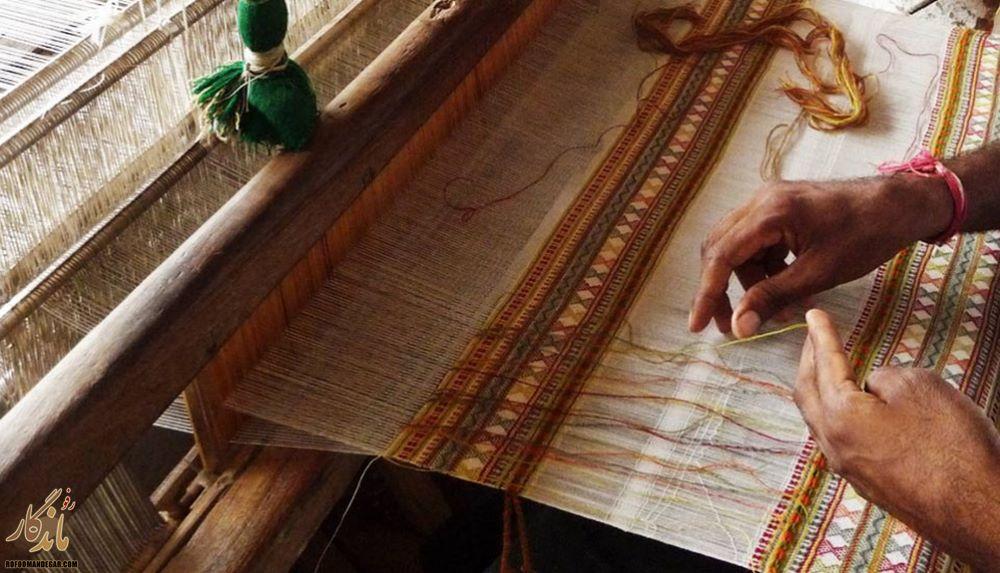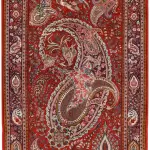Weaving mechanism and characteristics of full-length carpets
Lule weaving is the third method or weaving mechanism of Iranian handwoven carpets , it has its own technical and appearance characteristics. In this article, we are going to examine the features and how to weave full-length carpets. In the full-loop mechanism, after finishing each row of weaving, the weaver uses two wefts with different thicknesses for wefting, in such a way that first one of the wefts (thick weft) passes under the cross and is stretched well using strong strokes. Daftin is beaten well. After that, the thick tissue is placed on the thick tissue from the top of the cross and with slow strokes.
Carpet weaving method
In this method of weaving, like half-roll carpets, due to the use of two wefts, all the cheleis are placed upside down and on two different levels. But the difference between these two methods is that in full-length carpets, due to the strong pulling of the thick weft (under-weft) and also the significant difference in thickness between the under and top weft, the piles are more distant from each other than half-loop carpets, and the difference in their surface is somewhat are almost facing each other.
Reasons for loop weaving in Iranian handwoven carpets
According to the definitions provided so far of the three methods of flat weaving, half-loop and full-loop, the following can be considered among the most important features of full-loop carpets:
1- Using two wefts with different thicknesses after finishing each row of weave in full-length carpets.
2- Pulling and firmly hitting the first weft or thick weft in each row of the fabric, which causes the threads to be completely separated from each other and placed on two levels, below and below.
3- Due to the mentioned method of weaving in full-length carpets, the cross section of the knots is square and the length and width of each knot is the same. As a result, the curved lines and rotating motifs are only in this texture mechanism, which appear completely curved and in their original form. As mentioned earlier, in flat-woven and half-loop carpets, the rotating motifs were transformed into geometric or semi-geometric shapes.
4- If the weave is correct and the weaver has sufficient skill in wefting, the full-length carpets from the post are completely regular and uniform, and the thick or thin weft from the carpet post is not visible.

The history of the triple mechanisms of carpet weaving and full loop weaving in Iran
The evidence obtained from the examination of the oldest samples of Iranian hand-woven carpets, such as the Pazirik carpet, shows that Iranian weavers have been aware of the necessity of using two wefts (one weft and one weft) in carpet weaving since at least 2500 years ago. But the exact time of using the loop weaving mechanism is not known; But due to the fact that the evolution of the motifs in the tufted carpet has been in such a way that the motifs have evolved from completely broken to half broken and half rotating and finally to fully rotating patterns, so it can be concluded that the first mechanism used in weaving Historical carpets were flat-woven. Because it is in flat weaving method (using only one thin weft) that the texture of geometric motifs is an inevitable result of the weaving method and does not depend on the taste and desire of the weaver. Since the evolution of motifs in handwoven carpets was first broken motifs, then semi-rotating and finally rotating motifs, it can be accepted that the first historical carpets had a flat-weave weft method, that is, probably two or more thin wefts after completion. Every row of texture is used. Although there is no evidence of the existence of flat-weave carpets among the historical samples obtained, what is clear is that the continuation of the flat-weave tradition has reached the present period from an unknown time, and the texture of double-weave carpets is currently among the Turkmen peoples. And Baloch is still common.
Historical evidences of the weaving of semi-woven and full-woven carpets
With the progress of the art-industry of carpet weaving and in the later stages, the weavers realized that in order to achieve rotating motifs, they should increase the thickness of the wefts used. Therefore, by increasing the thickness of both the upper and lower wefts, this need was fulfilled to some extent, and the motifs were largely removed from the geometric form and became semi-rotary. It is at this stage that the semi-loop weave mechanism in Iranian carpets begins. Currently, a historical example of this pattern (Pazirik carpet) is available, and in addition, there are thousands of new examples of authentic Bakhtiari and Kurdish carpets, etc. Therefore, it can be said with certainty that the attempt to weave half-loop carpets and to achieve rotating motifs started before the Pazirik carpet and it has gone through its stages of evolution before that. The evidence obtained and the studies of experts such as Dr. Ali Hasuri show that most likely, Iranian carpets entered a new stage in the 9th century AH in order to progress towards the creation of completely rotating designs. In fact, it is from the beginning of the Timurid period that simultaneously with the changes made in the style of Iranian painting, the design of the carpet pattern also underwent changes and transformations, and Iranian weavers used the method of using two wefts with different thicknesses to weave carpets with completely rotating patterns, that is, the full loop method. invented From that time until today, the loop weaving mechanism has expanded so much that now most of the weavers use this method of weaving even in the most remote places, and this is the reason why all kinds of revolving motifs, including salimis and khatais, and flower and bush motifs, are found in all Iranian carpets. can be seen
Full-length carpet in the Achaemenid era
What is certain is that during the Achaemenid period, Iranian weavers were well acquainted with this method of weaving, because the historical Pazirik carpet was woven using this method. Finally, it is in the 9th century of Hijri and in the Timurid period that the efforts of weavers to create carpets with completely rotating motifs come to fruition, and with the weaving of carpets in the full-loop method and the use of two thin and thick wefts in carpet weaving and creating rotating motifs, the evolution of the technique Weaving in Iranian carpets is perfected and this weaving mechanism has continued to this day.
The range of hand-woven carpets in a full-scale way
Currently, most regions of Iran weave their hand-woven carpets in a full-length way, and flat and half-length carpets are popular only in some parts of Iran, which shows the continuation of the ancient and original tradition of Iranian carpet weaving. For example, we can mention the original and famous Turkmen and Baloch carpets, which are still woven in the old flat-weave method and, as a result, have geometric and broken patterns. Or about the carpets of Eilat Bakhtiari and Kurdistan, it can be said that they still use the semi-loop mechanism in creating their hand-woven fabrics, and thus the patterns of the carpets of these regions are semi-rotary.
Conclusion
Finally, it can be said that flat-weave mechanism was the first method used for hand-woven Iranian carpets, which has been used in the weaving of carpets since the most ancient times. This method of weaving causes broken and geometric motifs to appear in the carpet. Over time, weavers realized that in order to achieve rotating motifs, they had to increase the thickness of the weft thread, and this is how the semi-loop mechanism was born.
You can inquire about Buying Handwoven Carpets , Buying Handwoven Kilim and Mats , and Buying Handwoven Pictorial Rug Tableaus online from the Hoveida Carpet Store and register all your orders and Wherever you are in the world, deliver it to the desired address in less than 4 working days.
If you are interested in reading other articles in the field of Handwoven carpets or Handwoven Pictorial Rug Tableaus , please refer to Hoveida Carpet Commercial












